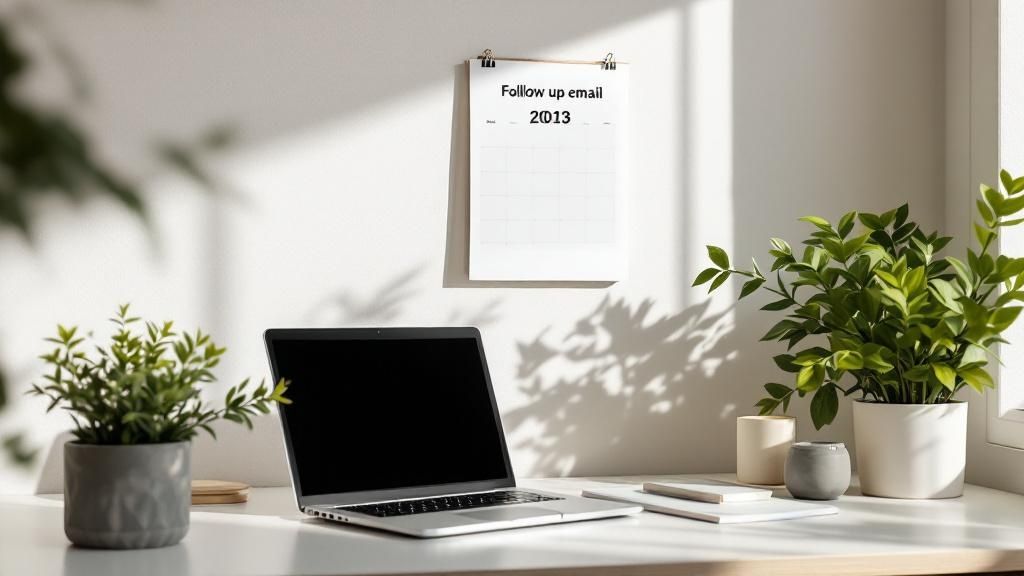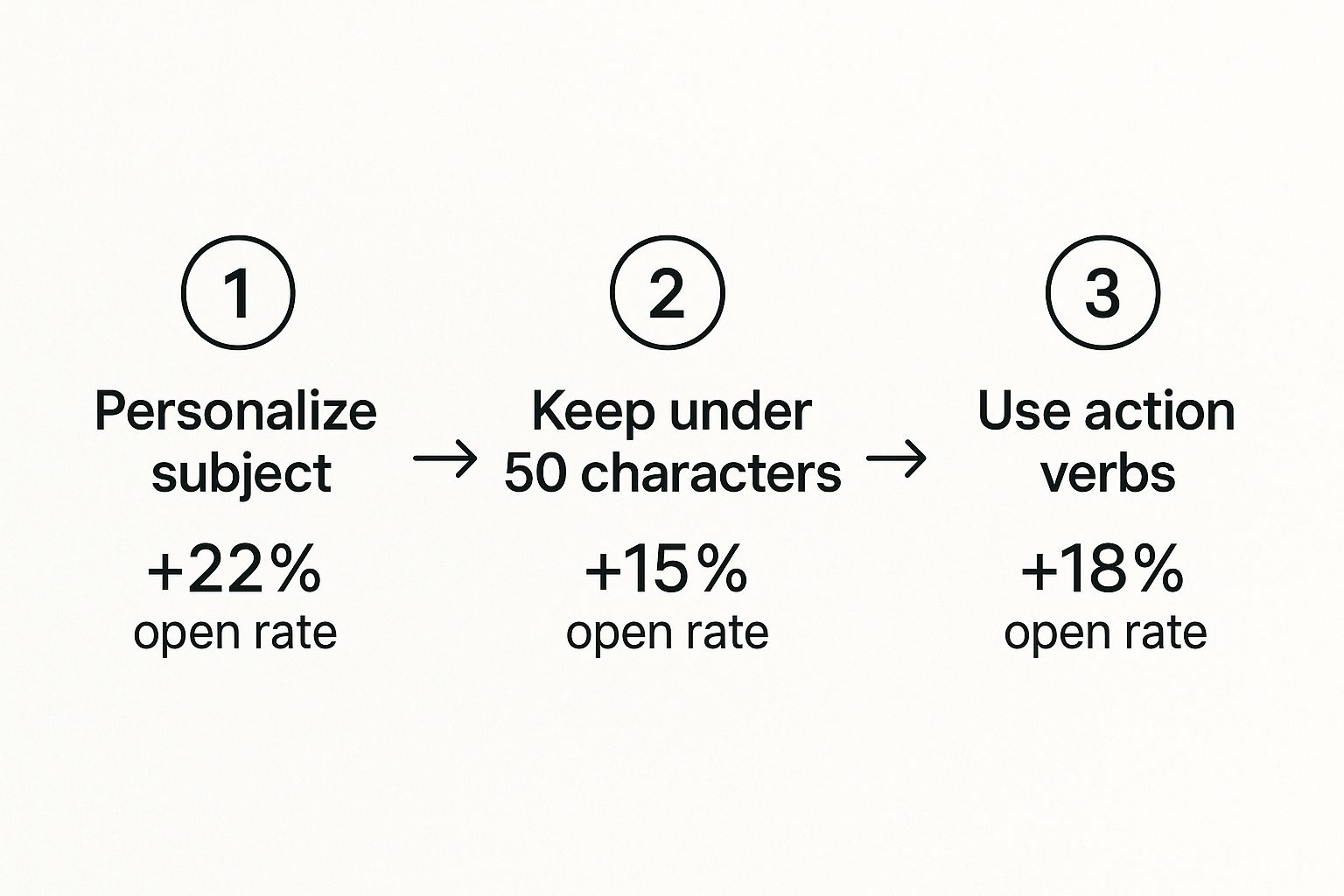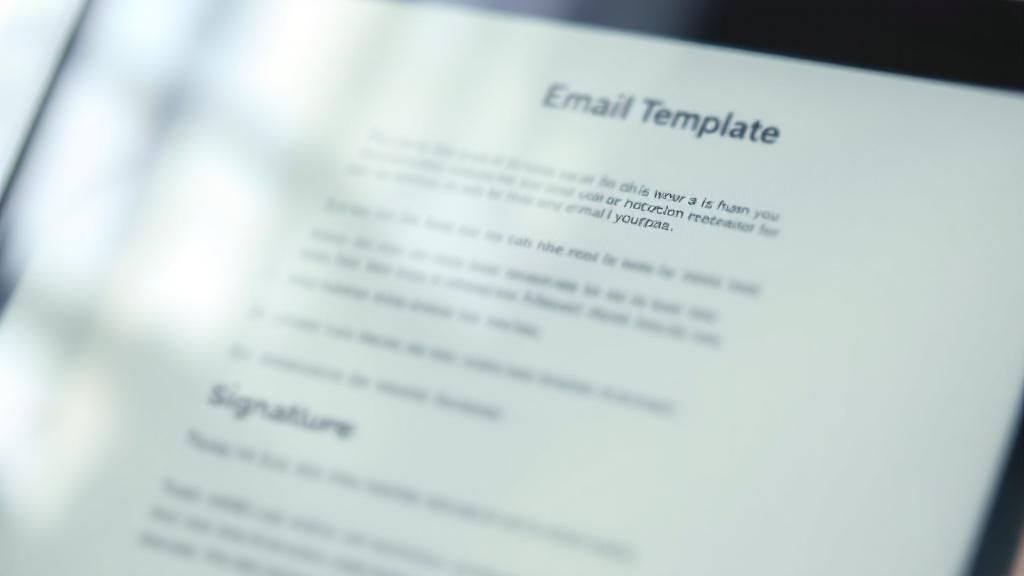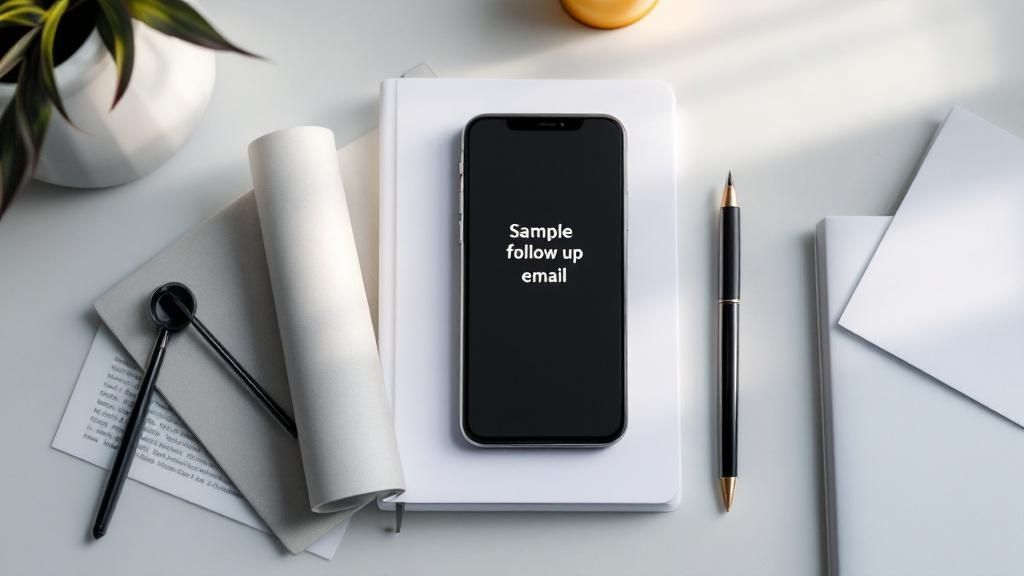It’s a familiar sting: you spend time crafting the perfect email, hit send, and then… crickets. But before you jump to conclusions, let me tell you from experience: the silence is almost never personal.
Most of the time, your message simply got lost in the shuffle. It might have been bad timing, a ridiculously full inbox, or it just didn't scream "read me now!" loud enough. That’s where a gentle, value-added follow up email after no response comes in. It’s your secret weapon for getting back on their radar.
Why Your First Email Was Ignored

Before firing off another message, let's take a quick look at why the first one might have slipped through the cracks. The modern professional is drowning in emails. It's completely normal for someone to open your message, intend to reply later, and then have it buried under a digital avalanche.
There are a ton of reasons for the radio silence, and frankly, most have zero to do with you or what you're offering.
Common Reasons for No Response
- Bad Timing: You might have hit their inbox during a chaotic morning, in the middle of a critical meeting, or right as they were logging off for the day.
- Inbox Overload: The average professional gets over 120 emails a day. Yours is just one of many vying for a sliver of their attention.
- No Clear Value: If the recipient couldn't immediately see what was in it for them, they probably archived it and moved on. It’s human nature.
- Internal Hurdles: They could be waiting on a green light from their boss or input from another team before they can get back to you.
This is exactly why having a smart follow-up strategy is so critical. To get this right, you need a fundamental shift in your thinking.
The core principle of a good follow-up is to shift your mindset from "resending" to "re-engaging." You aren't just reminding them; you are providing another opportunity to connect by adding new value.
Just sending more emails isn't the answer; sending better, more thoughtful ones is. Data from cold email campaigns is pretty revealing. While the average response rate hovers around a bleak 4.1%, persistence truly pays off. And it gets even better—highly personalized campaigns aimed at smaller, well-researched groups can see response rates as high as 40-50%. If you want to dig into the numbers, check out this analysis of cold email response rates.
Before you send anything, it's worth reviewing the core tenets of a great follow-up. These principles are the foundation of any message that actually gets a reply.
Core Principles for a Successful Follow-Up Email
| Principle | Why It Works | Actionable Tip |
|---|---|---|
| Provide Context | Reminds them who you are and why you're emailing without making them search for the original message. | Start with a simple phrase like, "Just following up on my email from last week about…" |
| Add New Value | Gives them a fresh reason to engage. You're not just asking again; you're offering something new. | Share a relevant case study, a helpful blog post, or a quick tip related to their business pain points. |
| Keep It Brief | Respects their time and makes it easy to read and process on the go. | Aim for 3-5 sentences maximum. Use short paragraphs and get straight to the point. |
| Make a Clear Ask | Eliminates ambiguity. They should know exactly what you want them to do next. | Instead of "Let me know your thoughts," try a specific question like, "Are you free for a 15-minute chat next Tuesday?" |
Ultimately, a winning follow-up gives context, makes your request crystal clear, and offers an easy, frictionless way for them to reply. It’s how you turn a missed connection into a real conversation.
The Art of Timing Your Follow-Up
Figuring out when to send a follow-up email after getting radio silence is a bit of a delicate dance. Jump the gun, and you come across as pushy. Wait too long, and your original email is a distant memory, buried under a mountain of other messages.
The trick is finding that sweet spot.
Let's be real: most people aren't ignoring you on purpose. Their inboxes are chaotic. Your email just got lost in the shuffle. A perfectly timed follow-up isn't annoying; it's a helpful nudge that brings your message right back to the top of their list when they might actually have a second to deal with it.
Finding Your Follow-Up Cadence
So, what's the magic number? For most situations, like a warm sales lead or a recent networking connection, the sweet spot for that first follow-up is 2-3 business days after you sent the original email.
This gives them enough breathing room so you don't seem desperate, but it's soon enough that they'll still remember who you are. Honestly, sending a follow-up the very next day almost never works and can make you look unprofessional.
If that first nudge doesn't get a reply, don't throw in the towel. You just need to stretch out your timing for the next ones. A good rule I follow is to gradually add more time between each message.
Your sequence could look something like this:
- Follow-Up 1: 3 days after the first email.
- Follow-Up 2: 5-7 days after that first follow-up.
- Follow-Up 3: Another 7 days after the second one.
This approach shows you're persistent without blowing up their inbox. It’s a marathon, not a sprint.
Optimizing Your Send Times
Beyond just the day you send it, the time you hit "send" can make a huge difference in your open rates. You have to think like your recipient. Sending an email at 5 PM on a Friday? You can bet that's getting lost in the weekend abyss.
The data consistently points to a "prime time" for engagement: Tuesdays, Wednesdays, and Thursdays between 9 AM and 11 AM in the recipient's local time. This is when most professionals are at their desks, focused, and clearing out their inboxes.
That's a fantastic starting point, but getting even more granular can give you a real edge. If you want to dive deeper, you can explore a full analysis of the best time to send sales emails to really dial in your strategy.
This infographic also shows just how much a few tweaks to your subject line can do for your open rates.

The takeaway here is simple: a mix of personalization, keeping it brief, and using clear, actionable language makes your subject line—and your whole email—way more compelling. When you master your timing and your messaging, you've found the ultimate combo for turning silence into a real conversation.
Crafting an Email That Actually Gets Replies

Okay, enough theory. Let's get practical. A truly great follow up email after no response isn't just about reminding someone you exist. It's a subtle art—a mix of good manners, smart psychology, and crystal-clear communication.
The real goal is to make hitting "reply" feel like the easiest, most obvious next step for them. To do that, we need to break down the email into its essential parts and sharpen each one for maximum impact. From the subject line to your closing, every word matters.
Start with a Context-Rich Subject Line
Your subject line is the gatekeeper. If it's vague or boring, your carefully crafted email is dead on arrival. The good news is, you have an advantage with a follow-up: existing context.
Always, and I mean always, reply in the same email thread.
This one simple move keeps the whole conversation together and saves your contact the headache of searching their inbox to remember who you are. A killer follow-up subject line just adds a little extra context to the original.
Effective Subject Line Examples:
- Re: Project Proposal: "Re: Project Proposal – Quick question"
- Meeting Recap: "Re: Meeting Recap – Following up"
- Info Request: "Re: Info Request – Checking In"
They work because they're instantly familiar and signal a brief, relevant update. No guesswork required.
Write a Concise and Value-Driven Body
Once they've opened your email, the clock is ticking. You have just a few seconds to grab and hold their attention. Huge, rambling paragraphs are a surefire way to get your message sent straight to the trash.
Your follow-up needs to be direct, scannable, and focused.
Here's a pro move: add new value. Instead of just a hollow "checking in," offer them something genuinely useful that reinforces why you reached out in the first place. This proves you're thoughtful and truly invested in helping them, not just chasing a reply.
For instance, you could share:
- A link to a new case study relevant to their company.
- An insightful article that speaks to a challenge you discussed.
- A quick, one-sentence tip that could benefit their business.
The most successful follow-ups never just ask, "Did you see my last email?" They provide a new reason to engage, shifting the dynamic from a nag to a helpful nudge. This simple change in approach can dramatically increase your chances of getting a response.
If you're still getting the hang of outreach, it pays to study what works. Our guide on https://salesloop.io/blog/how-to-write-cold-emails/ has foundational tips that are just as critical for your follow-up game.
End with a Low-Friction Call-to-Action
This is the final piece of the puzzle, and it's where so many people drop the ball. A vague call-to-action (CTA) like "Let me know your thoughts" creates mental work for your recipient. You need to make it absurdly easy for them to say yes.
Your CTA should be a clear, simple, and specific question.
| Vague CTA (Avoid) | Low-Friction CTA (Use) |
|---|---|
| "Looking forward to hearing from you." | "Are you free for a 15-minute call next Tuesday or Thursday?" |
| "Let me know what you think." | "Does solving [problem] align with your Q3 goals?" |
| "Hope to connect soon." | "Would it be helpful if I sent over the one-page summary?" |
By asking a specific, easy-to-answer question, you remove all the friction. Replying becomes a quick, simple task. And this kind of thoughtful persistence pays off. Research shows that while a single email might net a 9% reply rate, sending just one follow-up bumps that to 13%. For experienced pros, the leap is even bigger—from 16% to 27%. You can dig into more of these follow-up statistics to see just how powerful it is.
Follow-Up Email Templates for Any Situation
Theory and strategy are great, but sometimes you just need a good template to get started. That's exactly what this is: a collection of ready-to-use frameworks for your next follow up email after no response.
Think of these less as rigid scripts and more as starting points. The real magic happens when you inject your own personality and specific details into them. Each one is designed to be short, polite, and value-focused, making it as easy as possible for the other person to reply.
After Sending a Proposal
You've sent the proposal. Now the waiting game begins. This follow-up is just a gentle nudge to get the conversation going again and uncover any roadblocks you might not see.
Subject: Re: [Project Name] Proposal
Hi [Name],
Just following up on the proposal for [Project Name] I sent over last week. Wanted to check if you had any initial questions I could help with.
I’m really excited about the possibility of working together on this.
Would a quick 10-minute call this week be helpful to talk it through?
Best,
[Your Name]
After a Sales Demo or Meeting
The demo went well, and the energy was high. The goal here is to keep that momentum. You want to quickly recap the value you discussed and lay out a clear, simple next step.
Subject: Re: Great chat about [Topic]
Hi [Name],
Thanks again for your time today. I really enjoyed our conversation about how [Your Company] can help [Their Company] solve [specific pain point].
Based on our chat, it sounds like the next logical step would be [specific next action].
Are you the right person to coordinate this, or is there someone else on your team I should connect with?
Cheers,
[Your Name]
Remember: The best follow-ups give a simple, direct path forward. By asking a clear question, you take the mental load off your contact, making it incredibly easy for them to give you the information you need. This one small detail can be the difference between getting a reply and getting ignored.
After a Networking Event
You hit it off with someone at a conference. This email is all about turning that brief handshake into a real professional connection. It solidifies the interaction and opens the door for a more meaningful conversation.
Subject: Great connecting at [Event Name]!
Hi [Name],
It was great meeting you at [Event Name] on Tuesday. I particularly enjoyed our chat about [specific topic you discussed].
As promised, here is that [article/resource] I mentioned that you might find interesting.
I'd love to continue the conversation sometime. Are you open to a brief call next week?
Best,
[Your Name]
The Gentle "Break-Up" Email
Look, it happens. After multiple follow-ups with no reply, you need a way to politely close the loop. This email creates a little respectful urgency and, funnily enough, often gets a response from people who were just swamped.
Subject: Is closing the loop on this appropriate?
Hi [Name],
I haven't heard back from you since we last discussed [Project/Topic], so I'm going to assume your priorities have shifted.
If that’s not the case, please let me know! Otherwise, I'll stop following up on this. I wish you and [Their Company] all the best.
Sincerely,
[Your Name]
Personalizing these templates is crucial, but automating the sequence is how you scale your outreach without losing that human touch. If you want to dive deeper into building a cadence that feels helpful, not annoying, check out our guide on whether you can schedule my follow up messages timing. It's packed with practical advice for getting your timing just right.
The Psychology of Persistence Without Being a Pest

Let's be real: there's a Grand Canyon-sized gap between being persistent and just being a pest. One builds relationships and closes deals. The other gets you blocked and burns bridges for good.
Getting this right is everything when you're staring at an inbox full of silence. The whole point isn't just to force a reply. It's about keeping the conversation positive and professional, even when you're getting nothing back.
The secret? Empathy. Put yourself in their shoes for a second. Their inbox is a warzone, and they're juggling a dozen other priorities. Your email is just one small skirmish in their much bigger battle.
Once you truly get that, your entire approach shifts. You stop thinking, "Why haven't they replied?!" and start thinking, "Just bumping this up in case now is a better time." That small change shows you respect their time and keeps the door propped open.
Know When to Hold 'em, Know When to Fold 'em
One of the biggest mistakes I see people make is giving up way too early. The numbers on this are wild. Did you know that while 80% of sales require at least five follow-ups, a staggering 92% of sales reps throw in the towel after just four tries?
That gap is a massive opportunity for anyone willing to be thoughtfully persistent. Even sending a single follow-up can boost reply rates by nearly 50%. You’re leaving money on the table if you don’t.
So, what's the magic number? There isn't one, but a solid cadence is somewhere between 3-5 touchpoints spread out over a few weeks. Each message should be a little lighter than the one before it, and your last one should always give them a graceful exit.
A respectful "break-up" email (we have a template for this later) is surprisingly powerful. It closes the loop professionally, shows you respect their decision, and, ironically, is often the one that finally gets a reply.
This whole process takes discipline. It's easy to get discouraged and stop, but consistency is what wins the game. If you're looking to build that muscle, there are some great resources out there that can help you improve self-discipline for lasting success.
Think Beyond the Inbox: The Multi-Channel Nudge
If your emails are just echoing into the void, it’s probably time to switch up your game plan. A multi-channel approach shows you're serious without completely flooding their primary inbox.
Here are a few ideas to get you started:
- Connect on LinkedIn: Send a connection request, but don't just use the default message. Add a short, personalized note that mentions your email.
- Engage with their content: See them post on LinkedIn? Leave a thoughtful comment. It’s a low-pressure way to pop back onto their radar.
- Pick up the phone: I know, I know. But sometimes a quick, friendly call is the fastest way to cut through the digital noise and get a straight answer.
Using a mix of these tactics makes you more memorable. It shows you’ve put in real effort and positions you as a dedicated pro, not just another unread email. This is how you turn radio silence into a real conversation.
Your Top Follow-Up Email Questions, Answered
Even when you've got your strategy down, sending that follow-up email can feel a bit like guesswork. Is it too soon? Am I being annoying? Let's clear up some of the most common questions I hear so you can hit "send" with confidence.
How Many Follow-Ups Is Too Many?
This is the million-dollar question, isn't it? While there's no single magic number, my experience—and plenty of data—points to a sweet spot. Aim for 2-3 follow-ups after your initial email.
Most of your hard-earned replies will come from that very first follow-up. After the third or fourth attempt, you start seeing diminishing returns and risk crossing the line into annoying. The key is to add a few more days between each message to give your contact some breathing room.
Should I Reply in the Same Thread or Start a New Email?
Always, always reply in the same thread. I can't stress this enough. It’s a simple courtesy that makes a huge difference.
Keeping the conversation in one place gives your recipient instant context. They don’t have to dig through their inbox to figure out who you are or what you first wrote about. This makes their life easier, which dramatically boosts your chances of getting a reply. The only exception is if the topic has completely changed, but that’s incredibly rare.
Your goal is to make replying as frictionless as possible. Using the same thread is the single easiest way to give your contact the context they need to respond quickly and effectively.
What’s the Best Subject Line for a Follow-Up?
Good news: you don't need a new one. Since you're replying in the same email thread, the best move is to just add a small, helpful nudge to the original subject line. You get to keep the familiar "Re:" prefix, which instantly signals a continuing conversation.
Try adding simple, professional phrases like these:
- Re: Project Proposal – Quick question
- Re: Meeting Recap – Following up
- Re: Info Request – Checking In
These work because they’re recognizable, not aggressive, and clearly state your purpose.
How Can I Automate Follow-Ups Without Sounding Robotic?
Automation is your best friend for staying consistent, but personalization is what gets you the meeting. The trick is to find a tool that lets you customize your automated messages deeply.
Write your follow-up templates as if you were sending them one at a time to a real person. Use custom fields for their name, company, and maybe even reference a specific pain point you discussed. Automation shouldn't remove the human touch; it should handle the tedious scheduling part so you can focus on crafting a message that genuinely connects.
Ready to stop chasing leads and start closing them? Salesloop.io automates your entire multi-channel outreach, from personalized email sequences to smart follow-ups, so you can book more meetings with less effort. See how it works at https://salesloop.io.





